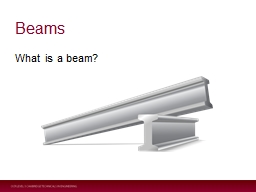

A beam is a structural element that carries transverse loads A beam is long compared to the dimensions of its cross section It does not carry loads in the direction along the length of the beam ID: 1019024
Download Presentation The PPT/PDF document "Beams What is a beam ? Beam - definition" is the property of its rightful owner. Permission is granted to download and print the materials on this web site for personal, non-commercial use only, and to display it on your personal computer provided you do not modify the materials and that you retain all copyright notices contained in the materials. By downloading content from our website, you accept the terms of this agreement.
1. BeamsWhat is a beam?
2. Beam - definitionA beam is a structural element that carries transverse loadsA beam is long, compared to the dimensions of its cross sectionIt does not carry loads in the direction along the length of the beam.
3. Types of beamEach type of beam is defined by how it is supportedAt each support there will be REACTIONS (i.e. reactions to the applied transverse loading)A reaction may be a vertical force (to maintain vertical equilibrium with the applied loads)Or a reaction may be a rotational moment (to maintain rotational equilibrium of the beam)
4. Types of beamNameSymbolReactionsSimply SupportedCantileverPropped CantileverContinuousEncastre
5. Statically determinate (and indeterminate) beamsStatic equilibrium gives 2 conditions for any of the beams on the last slide: Vertical equilibrium Rotational equilibrium Because beams do not carry loads along their length horizontal equilibrium does not provide any information about the beam.As we only have 2 useful equilibrium conditions we can only determine the reactions for any of the beams with only 2 reactions (2 forces or 1 force + 1 moments) using the method of static equilibrium.For all other types of beams more sophisticated methods of analysis must be used (not covered in this specification).
6. Types of loading‘Dead’ or ‘Self Weight’ loads (constant loads)‘Live’ or Imposed Loads (moving loads)Point loadsE.g. street furniture.E.g. Railway locomotive+ train.Uniformly distributed loadsE.g. Weight of the material used to construct the beam. (Often the largest load of all.)E.g. Design loading for general road traffic or pedestrians.